How many weeds can you name? Three? Five? Ten? There are tens more – and many of them may be growing in your garden right now.
Essentially, any plant that grows where it shouldn’t is classed as a weed. In this guide, we’ve shared the 16 most common garden weeds in the UK and discussed the best ways to get rid of them.
✅ Key Takeaways:
16 of the most common UK garden weeds are:
Dandelions
Creeping Buttercups
Daisies
Nettles
Dock Leaf
Clover
Cleavers
Horsetail
Creeping Thistle
Ragwort
Yarrow
Ground Elder
Chickweed
Japanese Knotweed
Hedge Bindweed
Celandine
Couch Grass
Table of Contents
🍀 16 Common Garden Weeds In The UK
Need help identifying common garden weeds in the UK? Below, we’ve shared the 16 weeds that occur the most commonly in the UK, alongside tips on how to identify them and how to remove them from your lawn.
Dandelions
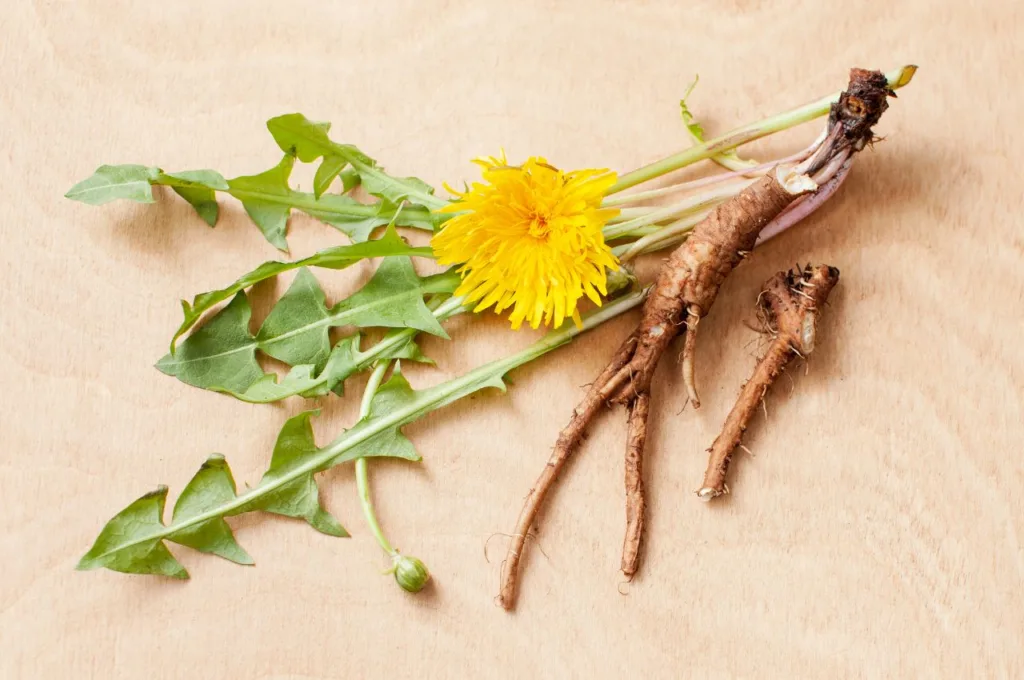
What Are They?
Dandelions (taraxacum officinale) are common perennial weeds that most of us know well. They’re considered both weeds and wildflowers and thrive in various environments, including lawns, meadows, and other urban areas.
How To Identify:
Dandelions have distinctive yellow flowers and fluffy white seed heads that disperse in the wind, enabling them to spread rapidly. Their leaves are deeply toothed and form a basal rosette, and their stems are hollow and exude a milky sap when broken.
How To Remove:
The easiest way to remove dandelions from your lawn is to manually pull them out, ensuring you remove the entire taproot to prevent regrowth. Another option is to use a selective herbicide for broadleaf weeds like dandelions. An eco-friendly approach is to use vinegar or boiling water to spot-treat individual plants. We also recommend regularly mowing your lawn to weaken dandelions and prevent them from flowering and producing seeds.
Creeping Buttercups
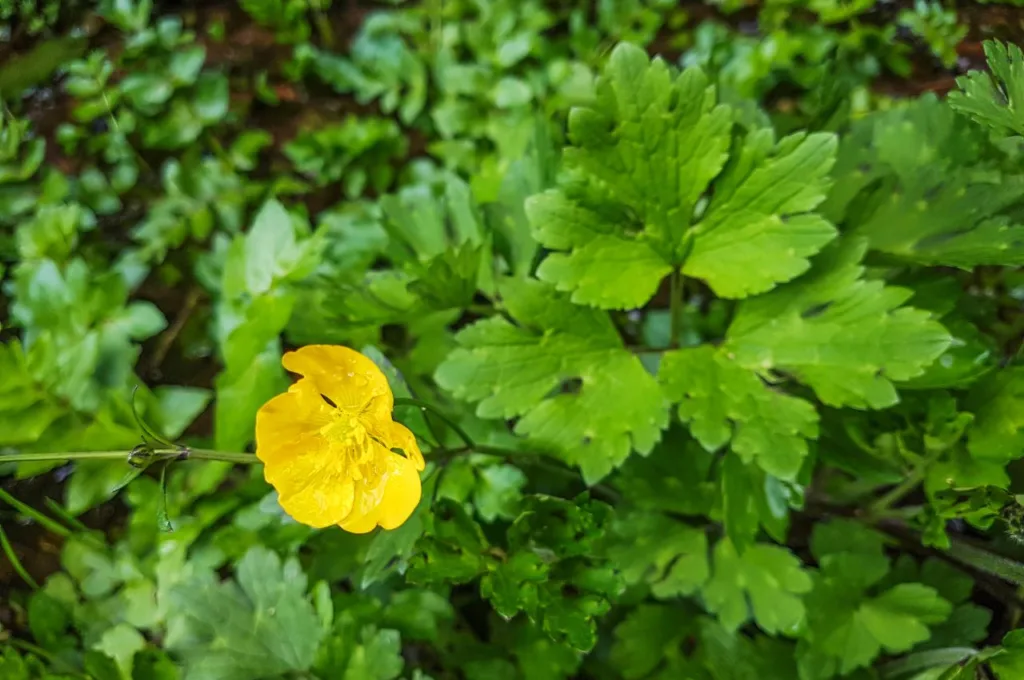
What Are They?
Creeping buttercups (Ranunculus repens) are perennial flowering plants that are known for their ability to spread quickly through their creeping runners and root nodes, forming dense mats in lawns, gardens, and other moist areas. You might enjoy the appearance of a buttercup’s vibrant yellow flowers, but this plant is often considered a weed due to its invasive nature and ability to outcompete desired plants.
How To Identify:
Creeping buttercups have heart-shaped, dark green leaves that are deeply lobed, creating a rounded or heart-shaped appearance. The bright yellow flowers of creeping buttercups have five petals and a glossy texture.
How To Remove:
To manage the growth of creeping buttercups, we recommend physical removal. Dig up the plants’ runners and roots, making sure to remove everything to prevent regrowth. Also work on improving soil drainage and maintaining a healthy lawn to discourage their growth.
Daisies
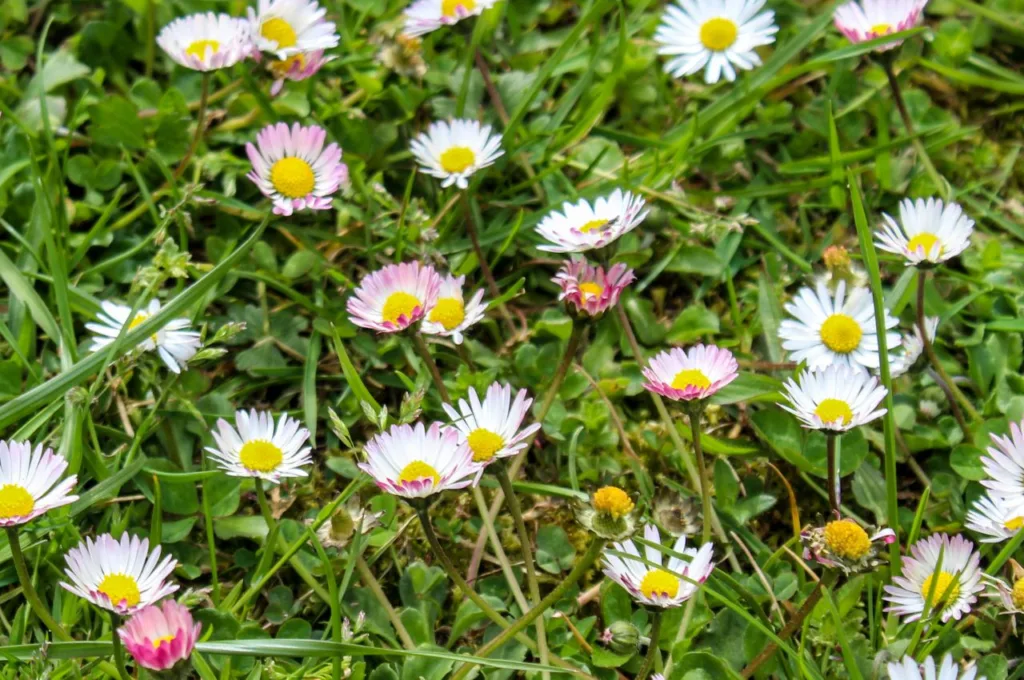
What Are They?
Common daisies (Bellis perennis) are a type of flowering plant belonging to the Asteraceae family, which also includes sunflowers and asters. These resilient and cheerful-looking flowers are usually found in gardens, meadows, and woodland. There are more than 40 different types of daisies, but the common daisy is the most persistent on UK lawns.
How To Identify:
You can recognize a daisy for its distinctive appearance, featuring white petals surrounding a central yellow disk that resembles a button. The plant grows close to the ground and has spoon-shaped leaves that grow in rosette form, and a thin, hairy stem. Each daisy plant produces a single flower.
How To Remove:
Our top recommended method of removing daisies is to dig them out of your lawn with a hand trowel or weeding too. You could also use a selective herbicide for broadleaf weeds, which will kill daisies without harming your grass. You’ll need to be persistent with your efforts if you want to prevent these fast-spreading plants from taking over your lawn.
Nettles
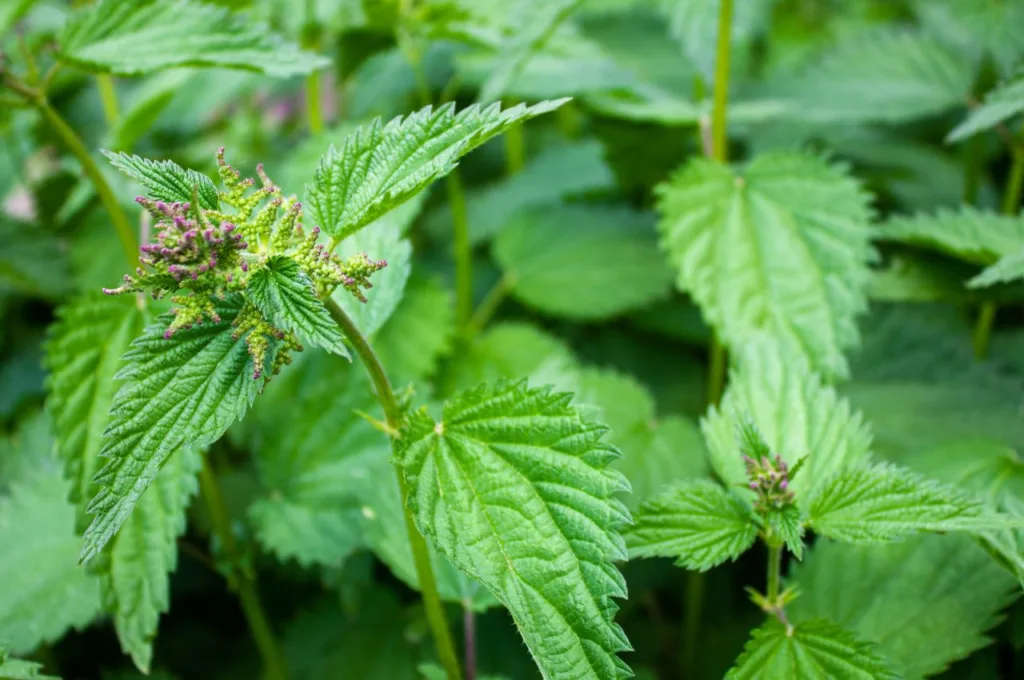
What Are They?
Nettles (urtica dioica), often referred to as stinging nettles, are perennial plants known for their serrated leaves and stinging hairs. If you’ve ever been stung by a nettle, you’ll agree that the feeling isn’t pleasant. These weeds are of the uglier kind, too, giving a lawn or garden a truly “forgotten” appearance. They belong to the Urticaceae family and are considered invasive due to their ability to spread rapidly with creeping roots.
How To Identify:
Nettles have ovate or heart-shaped leaves with serrated edges, which grow in pairs along the stem. These leaves are covered with fine, stinging hairs. Nettle stems are square and have the same coating of stinging hairs. They tend to grow in clusters and can reach varying heights, ranging from one to six feet. You’re most likely to find nettles growing in damp, shaded areas, such as behind your shed or against your fence, but they can quickly spread across a whole garden without regular upkeep.
How To Remove:
To remove nettles from your garden, first put on a pair of gloves, long sleeves, and trousers (these weeds fight back!). Nettles will grow back if you don’t remove them fully, so use a shovel or garden fork to dig up the entire plant, including the roots. Make sure to dispose of the removed plants safely to prevent them from regrowing. If you’re dealing with a larger infestation, you can instead use a selective herbicide for broadleaf weed control.
Dock Leaf
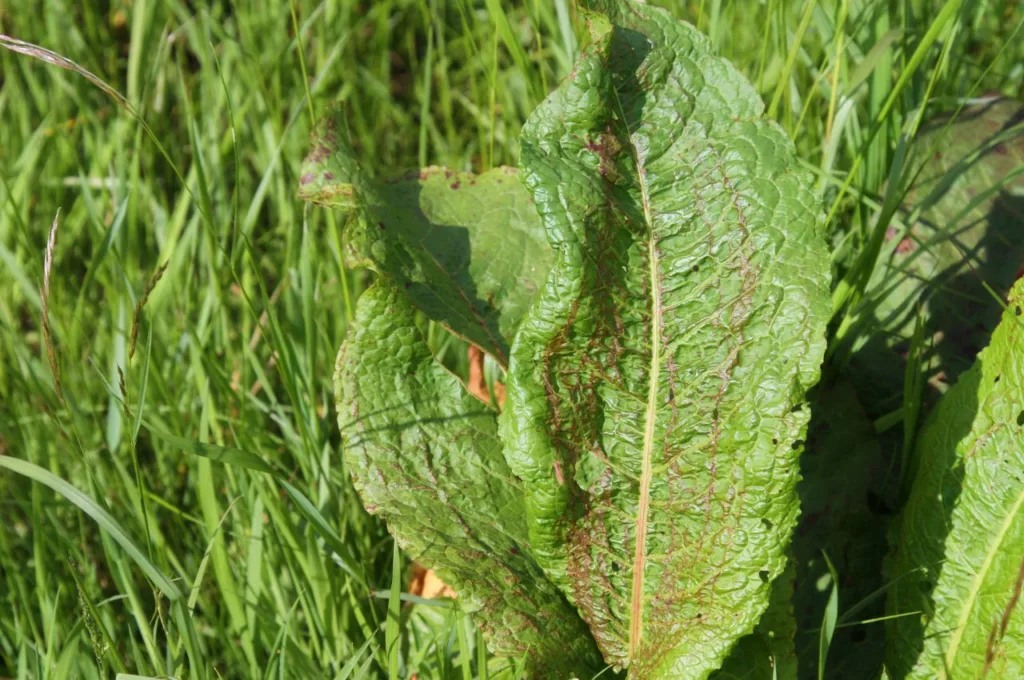
What Are They?
Docks (rumex obtusifolius) are the British grandparent’s antidote to nettle stings and are commonly (and helpfully) found alongside nettles. They’re perennial broadleaf weeds that belong to the Polygonaceae family. They thrive in a variety of environments, from meadows to waste areas, and are often considered invasive due to their prolific seed-spreading abilities.
How To Identify:
You can identify docks by their tall, erect stems and elongated, lance-shaped leaves that usually have a distinctive wavy or curly edge. These woody weeds produce tall, thin clusters of inconspicuous flowers that turn into seed heads.
How To Remove:
The most effective way to remove docks is to dig them up using a garden fork or shovel, making sure to remove the entire taproot to prevent regrowth. Dispose of the removed plants to prevent them from re-establishing. You can use a broadleaf herbicide to efficiently tackle a larger infestation (follow the manufacturer’s instructions carefully).
Clover
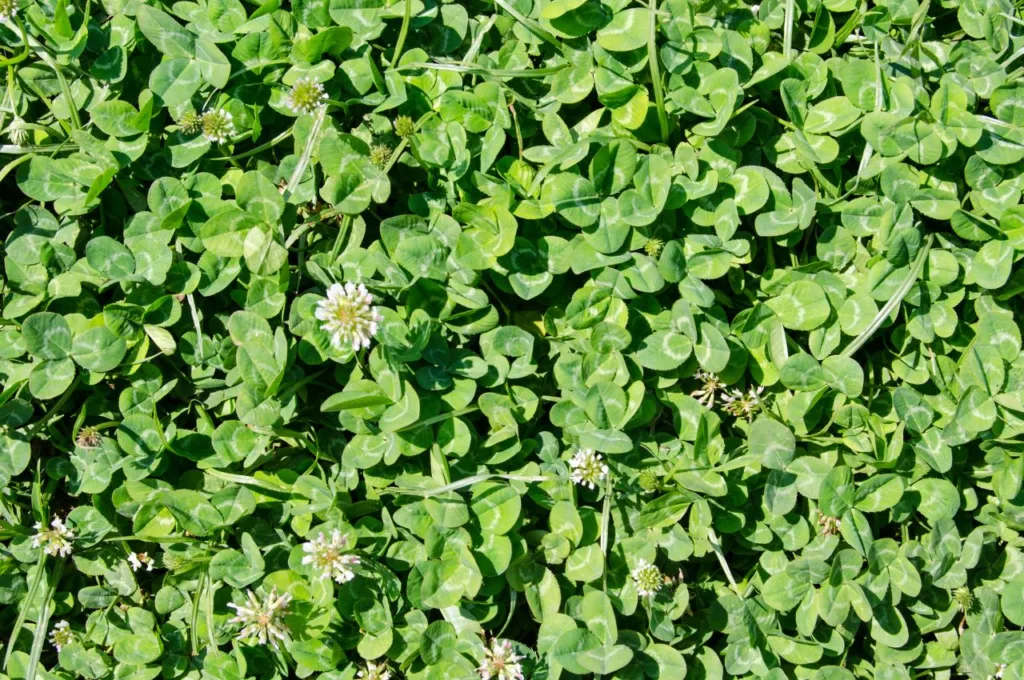
What Are They?
Clovers (trifolium repens) are low-growing, herbaceous plants belonging to the Fabaceae family. A four-leaf clover might apparently bring good luck, but clovers are still classed as weeds since they usually crop up in lawns and other areas where they’re not wanted. Interestingly, clovers are one of the few weeds that have ecological benefits: they can extract nitrogen from the air into the soil, which can improve soil fertility.
How To Identify:
Clovers can be identified by their distinct trifoliate leaves, which consist of three leaflets attached to a single stem. They have thin stems and produce small, clustered white, pink, or purple flowers, and resemble round pom-poms. Clovers are low-growing plants, typically reaching a few inches in height. They are commonly found in lawns, fields, and meadows in the UK.
How To Remove:
If your garden only has a few small patches of clovers, the easiest way to remove these lawn weeds is by pulling or digging out the individual plants. Otherwise, try letting your grass grow longer and mowing your lawn at a higher height, which shades out clover and weakens its growth. Applying nitrogen-rich fertilizer to your lawn can also help grass plants outcompete clover, as clover prefers low nitrogen levels
Cleavers
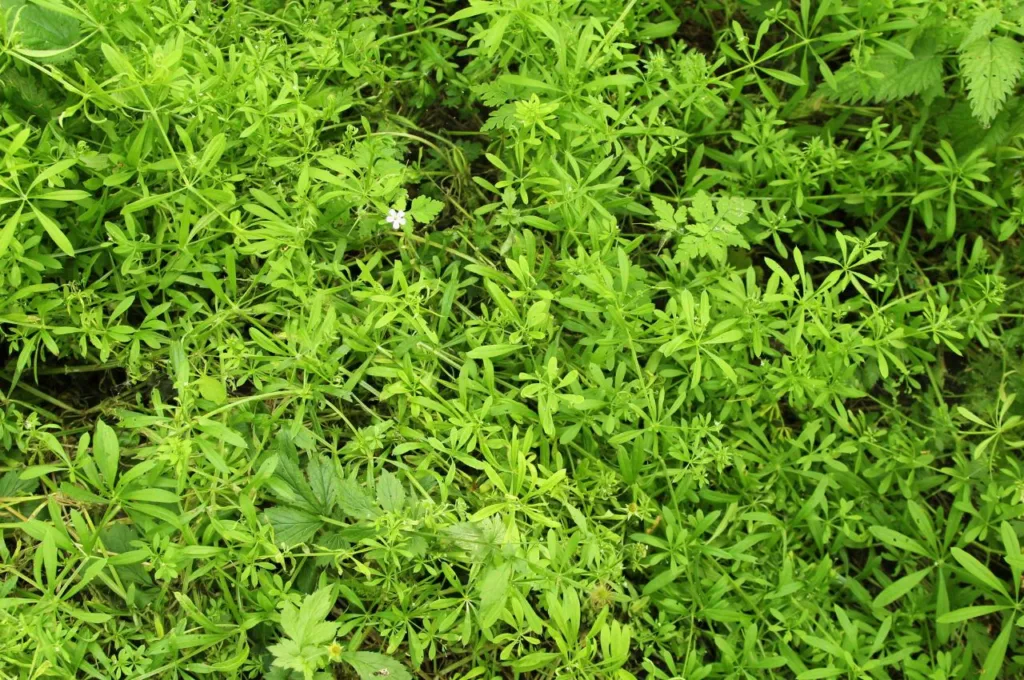
What Are They?
Cleavers (galium aparine), also known as stickywilly or goosegrass, are annual flowering plants belonging to the Rubiaceae family. These sticky plants grow in a variety of environments, including gardens, fields, and waste areas, often climbing and intertwining with other vegetation.
How To Identify:
Cleavers are recognized for their sticky, clinging nature and small, white, star-shaped flowers. They have their slender stems covered with tiny hooked hairs that allow them to adhere to surfaces (including pets’ fur!) and spread easily. Cleavers have whorls of leaves that usually occur in groups of six to eight along the stem.
How To Remove:
Removing cleavers is a sticky business, so begin by putting on a pair of gloves to avoid getting entangled with the plant’s hairs. Hand-pulling is effective for small infestations – gently uproot the plants, making sure to remove as much of the root system as possible. For larger areas, mow the cleavers before they flower and produce seeds to help control their spread.
Horsetails
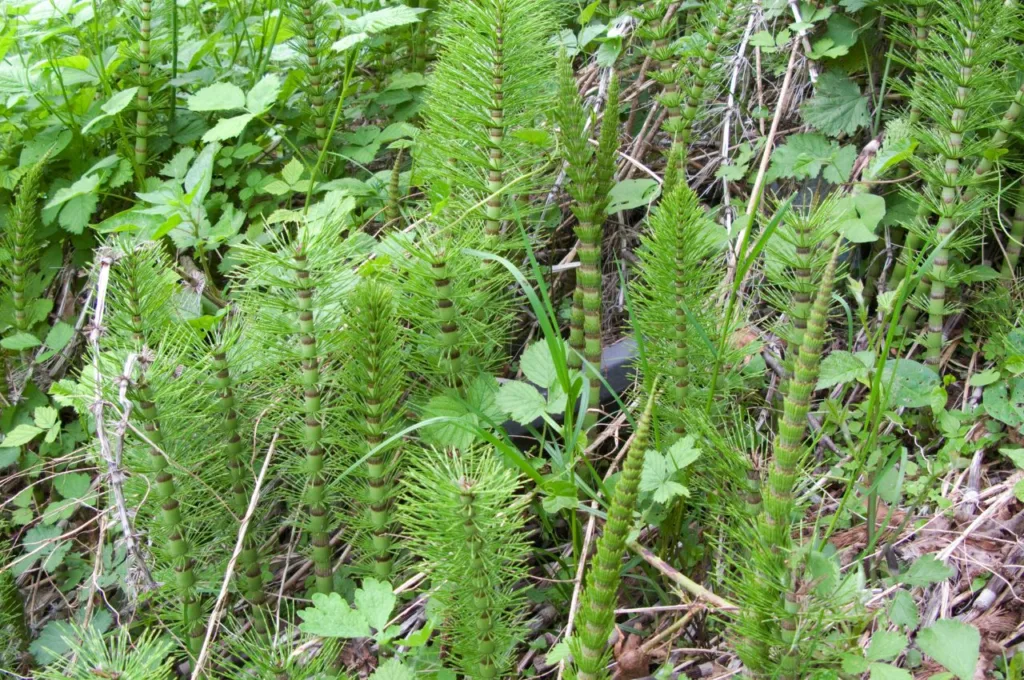
What Are They?
Horsetails (equisetum) are ancient and unique plants that belong to the Equisetaceae family. These weeds are aggressive spreaders and are widely distributed in the UK on lawns, meadows, roadsides, paths, and wastelands. We’re particularly fascinated by horsetails because they’re the only plant to reproduce by spores rather than seeds. Still, a weed is a weed!
How To Identify:
recognizable by their distinct appearance, characterized by jointed stems that resemble bamboo and spore-producing cones at the tips. Horsetails lack true leaves; instead, they have needle-like structures arranged in whorls around the stem joints. These plants thrive in moist habitats such as wetlands, ditches, and riverbanks.
How To Remove:
You can remove small spots of horsetails by digging up the plants (make sure to remove all of the plant to prevent regrowth). For larger areas, mow your lawn regularly or cut the horsetails before they produce spores, which should weaken their growth over time. You should also see success from using a systemic herbicide for horsetail control can be effective, but it might need multiple applications due to the plant’s hardy nature. You can prevent horsetail spread by improving your lawn’s soil drainage.
Creeping Thistle
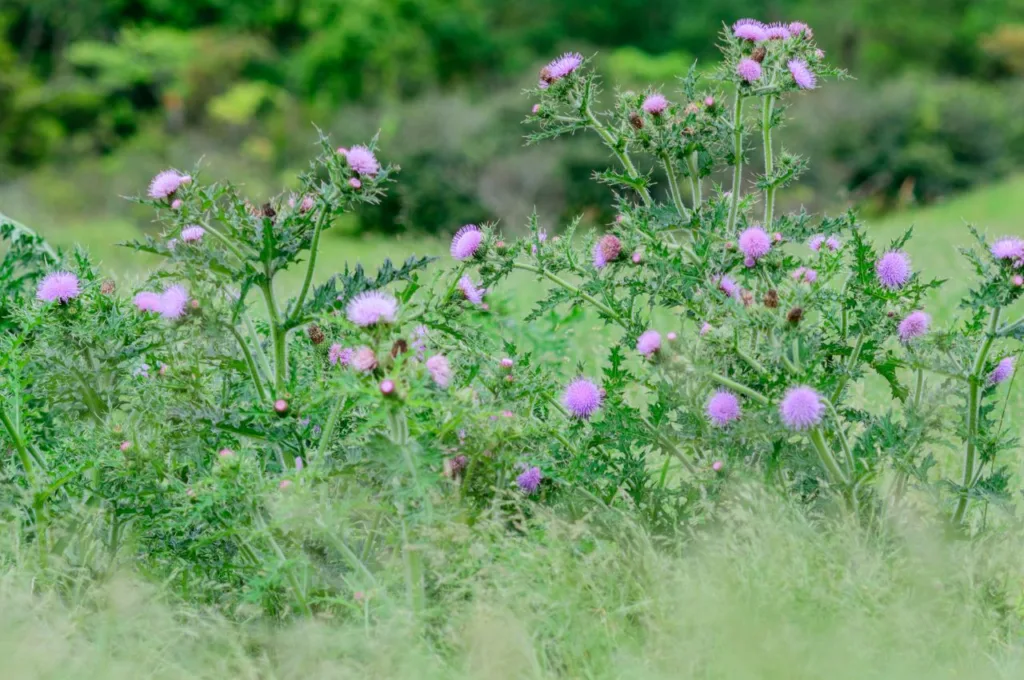
What Are They?
Creeping thistle (cirsium arvense) is a perennial weed known that spreads aggressively due to its continually growing underground horizontal stems. This plant belongs to the Asteraceae family and is sometimes found in lawns, as well as pastures and roadsides. Creeping thistle is another attractive plant, but its invasive nature and ability to compete with desirable vegetation make it a challenging weed to manage.
How To Identify:
You can identify creeping thistle from its deeply lobed, spiky leaves with serrated edges that form a rosette at the base, and its distinctive tubular pink or purple flower heads. A mature creeping thistle has tall, upright stems that can reach several feet in height. When undisturbed, the weed often grows in dense patches.
How To Remove:
You’ll need some perseverance when tackling creeping thistle in your garden – it’s an aggressive spreader. Put on a pair of gloves and dig up the plant, removing as much of the roots as possible. Dispose of the removed thistle plants to prevent regrowth. For larger infestations, use a herbicide for thistle control.
Ragwort
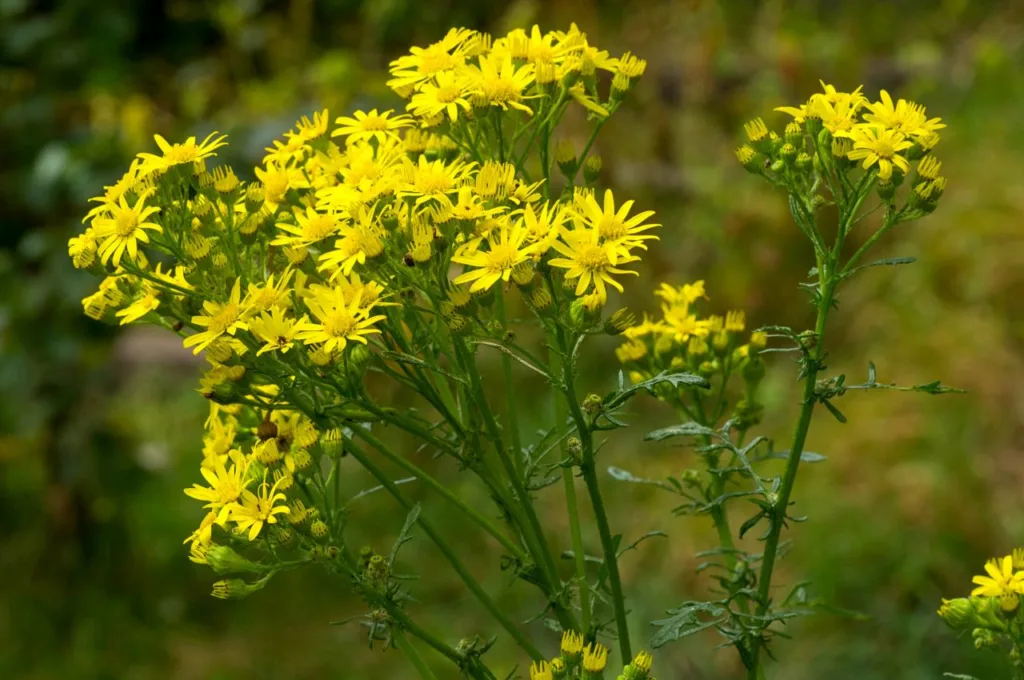
What Are They?
Common ragwort (senecio jacobaea) is a biennial or perennial plant belonging to the Asteraceae family. It’s often found in pastures, meadows, and along roadsides, and can produce large quantities of wind-borne seeds, which contributes to its invasive nature and rapid spread. Ragwort contains alkaloids that can have toxic effects if ingested by animals.
How To Identify:
Common ragwort is characterized by its bright yellow, daisy-like flowers and dark green, deeply lobed leaves that form a basal rosette at the base of the stem. The plant typically grows 1 to 3 feet tall and produces a strong, bitter odor when the leaves are crushed.
How To Remove:
To remove small infestations of ragwort, put on a pair of gloves an hand-pull the plants, ensuring you remove the entire root to prevent regrowth. Dispose of the plants in your garden bin or another way that prevents seeding. For larger areas, mow the ragwort before it flowers to help reduce its spread. You can also consider using a systemic herbicide for broadleaf weed control.
Yarrow
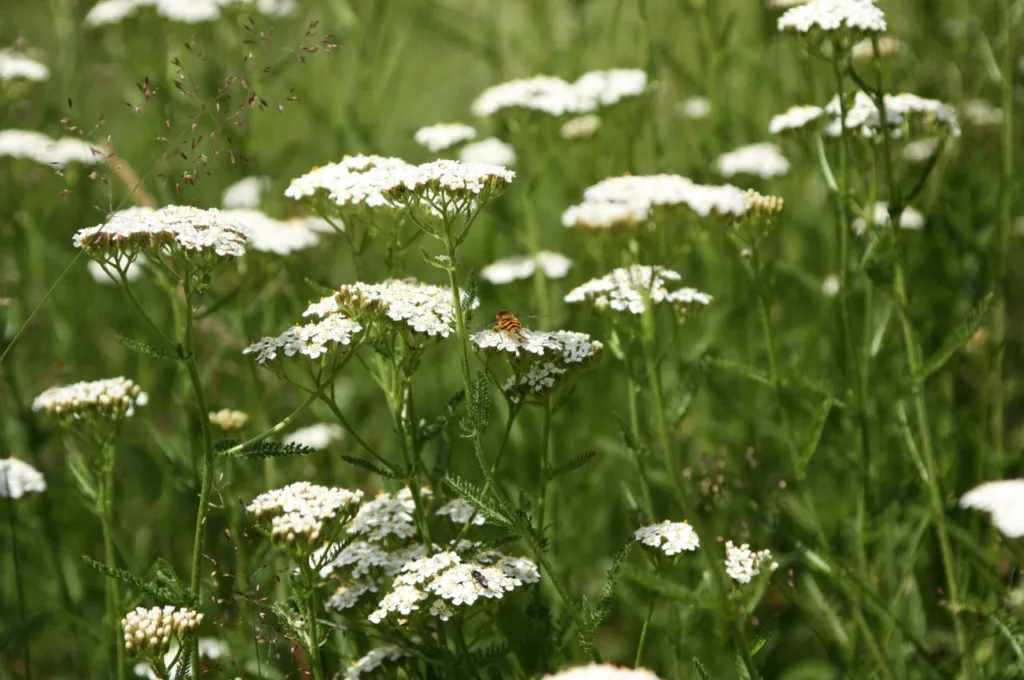
What Are They?
Yarrow (achillea millifolium) is a perennial plant that belongs to the Asteraceae family In its cultivated form, yarrow is a weed that’s often used in wildflower gardens or mixed herbaceous borders. But it’s considered a weed when it grows naturally in grasslands, gardens, fields, and wasteland due to its invasive and tenacious nature.
How To Identify:
Yarrow typically grows 1 to 3 feet tall and has feathery, fern-like leaves, which are found alternately along the stem. Yarrow produces clusters of small, flat-topped flowers at the top of the stems. These flowers are either white, pink, or yellow, and have a distinctive aromatic scent (we think it’s a bit like chamomile).
How To Remove:
Remove small infestations of yarrow by hand-pulling the plants, ensuring you remove the entire root system. For larger areas, mow your lawn regularly to prevent the growth of flowers (therefore preventing spreading via seeds). You can also cultivate your garden soil to disrupt the plants’ root system. As a last resort, apply a herbicide for broadleaf weeds.
Ground Elder
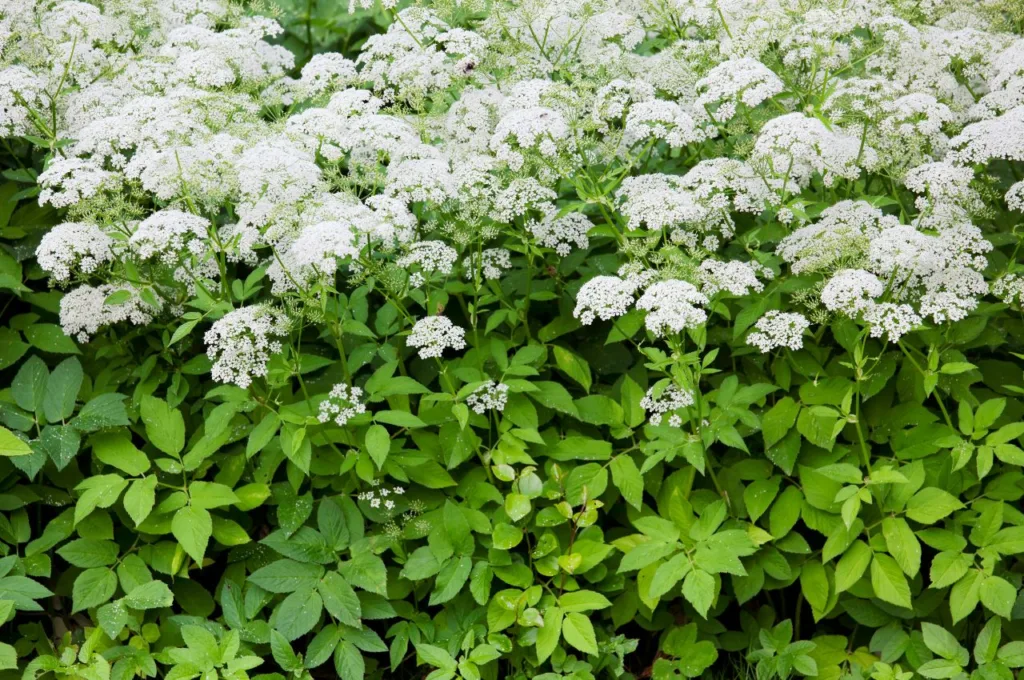
What Are They?
Ground elder plants (aegopodium podagraria), also known as goutweed, are perennial plants belonging to the Apiaceae family. Goutweed is considered an invasive weed due to its aggressive spreading with underground stems, making it challenging to control. It’s commonly found in shaded areas, gardens, and along fences and walls.
How To Identify:
You can identify ground elder by its bright green, three-parted leaves that bear a resemblance to celery, and its small, white umbrella-shaped flowers, which are held above the foliage on tall stems.
How To Remove:
The most effective way to remove ground elder is with the gradual process of regularly cutting the foilage just below ground level. This will cause the plant to weaken and eventually die. Make sure to stick to a strict routine – the cutting should be done every 7-10 days to prevent regrowth. An alternative method of removal is to fork through the soil once every two weeks, removing all the ground elder roots as you go.
Chickweed
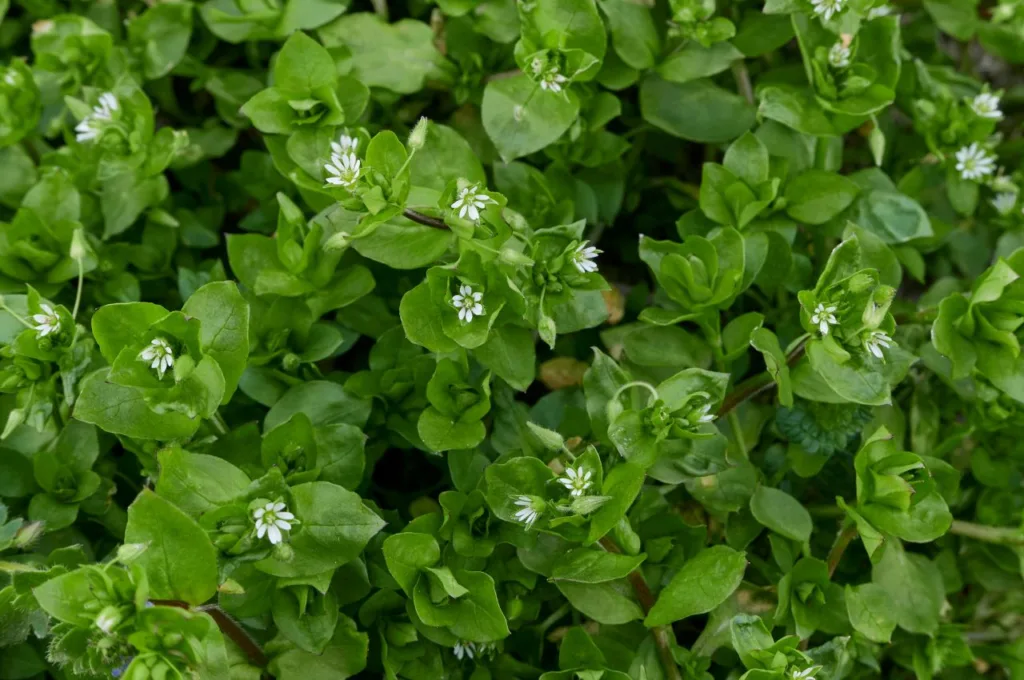
What Are They?
Chickweed plants (stellaria media) are common annual or winter annual weeds known for their small, delicate leaves and white star-shaped flowers. They belong to the Caryophyllaceae family and are often found in gardens, lawns, and other suburban areas.
How To Identify:
Chickweed’s leaves are oval or lance-shaped and have a smooth texture. The chickweed plant produces small clusters of white flowers with five deeply notched petals. Chickweed has a prostrate growth habit (meaning it spreads horizontally along the ground) and can form dense mats over surfaces.
How To Remove:
You can remove chickweed by pulling it out by hand – and we recommend this method above non-natural alternatives, like herbicides. Once common chickweed has been removed by hand-pulling, it won’t grow back.
Japanese Knotweed
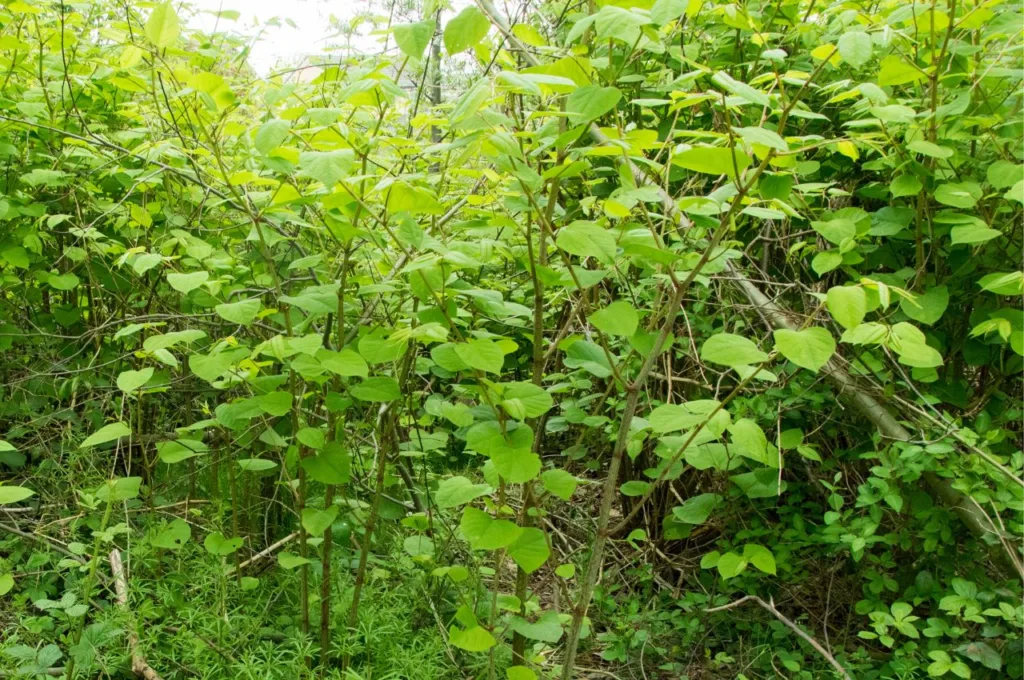
What Are They?
Japanese knotweed (botanical name: fallopia japonica) is a highly invasive perennial plant native to East Asia that, since being introduced by the Victorians as an ornamental plant, now grows in almost every area of the UK. It grows aggressively and is a problematic weed that can damage structures, roads, and native vegetation.
How To Identify:
You can recognize Japanese knotweed by its bamboo-like appearance, with tall, hollow stems that can reach heights of up to 10 feet. The leaves are large, heart-shaped, and arranged alternately along the stem. Japanese knotweed produces small, creamy-white to greenish flowers in late summer or early autumn.
How To Remove:
Because it grows so aggressively, Japanese knotweed can only effectively be removed with repeated fertiliser application. You can either hire a professional to treat an infestation for you or address the issue yourself. Two to three years of repeated treatment using glyphosate-based herbicides is the best way to get rid of Japanese knotweed for good.
Hedge Bindweed
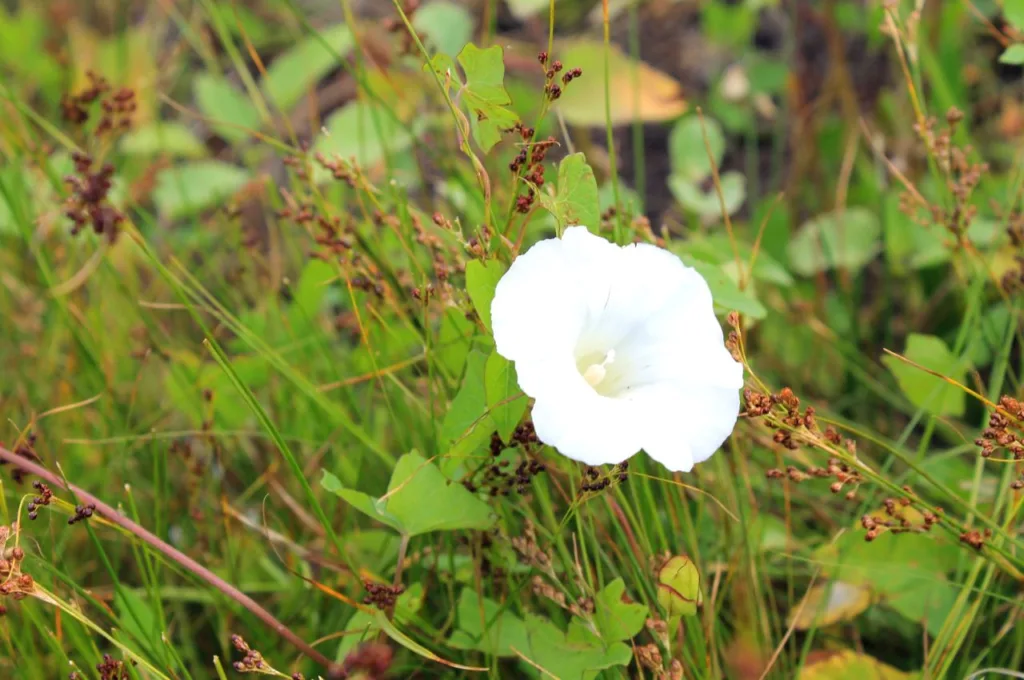
What Are They?
The hedge bindweed plant (calystegia sepium), also known as wild morning glory, is a climbing perennial plant that belongs to the Convolvulaceae family. This weed is common and widespread across the UK, often found in gardens, fields, and other residential areas. Hedge bindweed has pretty flowers, but it’s capable of spreading rapidly and smothering other vegetation, so you may want to keep it out of your garden.
How To Identify:
Hedge bindweed is identifiable by its twining vines that can climb and entangle other plants, fences, and structures. Its arrow-shaped leaves are smooth and alternate along the stem. The plant produces funnel-shaped flowers that are either white or pink and have a similar appearance to morning glory flowers.
How To Remove:
The most effective treatment for hedge bindweed is a systemic weedkiller containing glyphosate. It’s important to be really careful when using glyphosate weedkillers as they’re nonselective, meaning that they kill all plants that they come into contact with. Follow the manufacturer’s instructions carefully.
Couch Grass
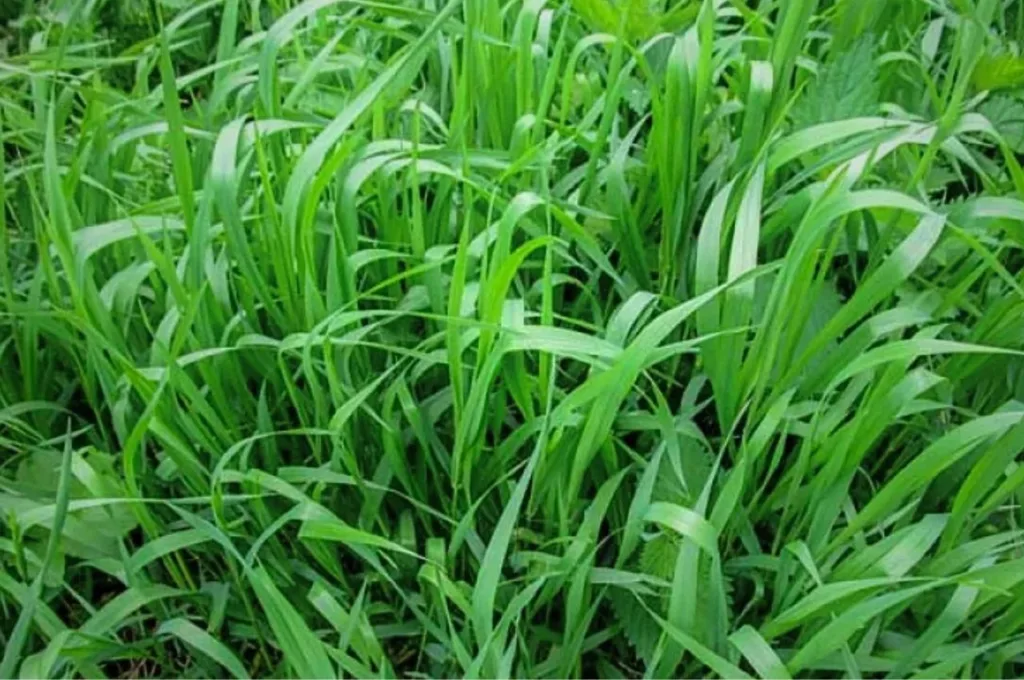
What Are They?
Couch grass (elymus repens) is a perennial grass species that’s known for its rapid growth and spreading nature, often being considered a weed in gardens, lawns, and agricultural fields. It has long, narrow leaves and produces an underground network of stems known as rhizomes, which allow it to quickly establish and form a dense network.
How To Identify:
You can identify couch grass by looking out for tufts of grass with long, narrow, rough textured leaves. One of the most distinctive features of couch grass is its creeping growth habit facilitated by underground stems called rhizomes. The plant’s roots are thick, wiry, brittle, and white in appearance. You’re most likely to notice a couch grass infestation on your garden borders or lawn.
How To Remove:
The best way to remove couch grass without affecting your desired lawn grass is to dig the weed out or suppress its growth with mulch. You need to make sure all sections of rhizomes are removed from the ground. If you leave any behind, these will regrow and form new networks. After removing the weed, wait a few weeks to ensure there’s no regrowth, then reseed the problem areas if needed.
🏁 Final Word
There are lots of other weeds that you may come across in the UK, but to avoid overwhelming you in this guide, we’ve focused on the most common types of weeds that you’re most likely to come across in your garden.
Even if you can’t identify a weed, the method of removal applies to most weed species anyway – so don’t worry, it’s not essential to know what you’re dealing with!
Liked this article? You might also enjoy:
FAQ:
What are the weeds that look like ferns in the UK?
The weed that looks like a fern in the UK is yarrow, a grey/green mat-forming plant that produces white or pink flowers and feathery leaves. Yarrow is tolerant of most climates or soils and is most commonly found in shaded areas, woodland, and heathland.
What weeds are in lawns?
The most common weeds found on lawns in the UK are dandelion flowers, clover, chickweed, daisies, and creeping buttercup (botanical name: ranunculus repens). You may notice these weeds growing sporadically or in clumps around your lawn surface.
Are there any poisonous weeds in the UK?
There are a few poisonous weeds in the UK, including giant hogweed (which has stems up to 14 feet tall and clusters of white flowers), common ragwort, which is very poisonous to animals (it’s identifiable by its thin, long leaves, 1-metre tall stems, and clusters of tiny yellow flowers), and hemlock (which has bright green, fern-like leaves and clusters of tiny white flowers).
What is the most invasive plant in the UK?
The most invasive plant in the UK is Japanese knotweed, which grows on roadsides, near rivers and streams, and in other parts of the country. The weed is actually more common in suburban areas – check this Horticulture Magazine UK map to see if your area is affected.
What are the sticky weeds in the UK?
The sticky weeds in the UK are clever, which are otherwise nicknamed “stickyweed”, “sticky willow”, or “sticky willy” due to their characteristic white seeds, which stick to everything (as you’ll know if you have a pet that likes to explore off the beaten path).
